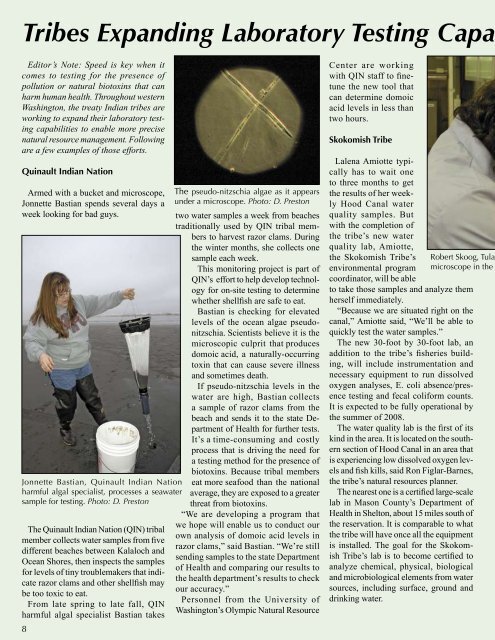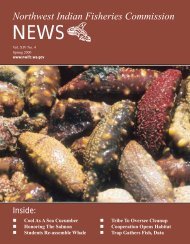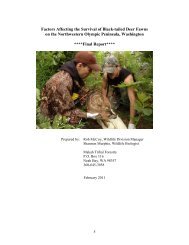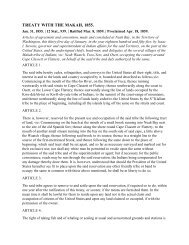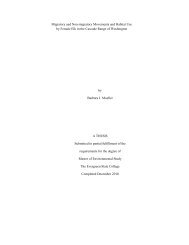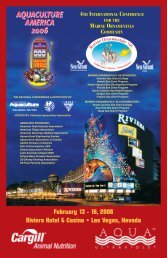NWIFC News - NWIFC Access - Northwest Indian Fisheries ...
NWIFC News - NWIFC Access - Northwest Indian Fisheries ...
NWIFC News - NWIFC Access - Northwest Indian Fisheries ...
You also want an ePaper? Increase the reach of your titles
YUMPU automatically turns print PDFs into web optimized ePapers that Google loves.
Tribes Expanding Laboratory Testing Capa<br />
Editor’s Note: Speed is key when it<br />
comes to testing for the presence of<br />
pollution or natural biotoxins that can<br />
harm human health. Throughout western<br />
Washington, the treaty <strong>Indian</strong> tribes are<br />
working to expand their laboratory testing<br />
capabilities to enable more precise<br />
natural resource management. Following<br />
are a few examples of those efforts.<br />
Quinault <strong>Indian</strong> Nation<br />
Armed with a bucket and microscope,<br />
Jonnette Bastian spends several days a<br />
week looking for bad guys.<br />
Jonnette Bastian, Quinault <strong>Indian</strong> Nation<br />
harmful algal specialist, processes a seawater<br />
sample for testing. Photo: D. Preston<br />
The Quinault <strong>Indian</strong> Nation (QIN) tribal<br />
member collects water samples from five<br />
different beaches between Kalaloch and<br />
Ocean Shores, then inspects the samples<br />
for levels of tiny troublemakers that indicate<br />
razor clams and other shellfish may<br />
be too toxic to eat.<br />
From late spring to late fall, QIN<br />
harmful algal specialist Bastian takes<br />
<br />
The pseudo-nitzschia algae as it appears<br />
under a microscope. Photo: D. Preston<br />
two water samples a week from beaches<br />
traditionally used by QIN tribal members<br />
to harvest razor clams. During<br />
the winter months, she collects one<br />
sample each week.<br />
This monitoring project is part of<br />
QIN’s effort to help develop technology<br />
for on-site testing to determine<br />
whether shellfish are safe to eat.<br />
Bastian is checking for elevated<br />
levels of the ocean algae pseudonitzschia.<br />
Scientists believe it is the<br />
microscopic culprit that produces<br />
domoic acid, a naturally-occurring<br />
toxin that can cause severe illness<br />
and sometimes death.<br />
If pseudo-nitzschia levels in the<br />
water are high, Bastian collects<br />
a sample of razor clams from the<br />
beach and sends it to the state Department<br />
of Health for further tests.<br />
It’s a time-consuming and costly<br />
process that is driving the need for<br />
a testing method for the presence of<br />
biotoxins. Because tribal members<br />
eat more seafood than the national<br />
average, they are exposed to a greater<br />
threat from biotoxins.<br />
“We are developing a program that<br />
we hope will enable us to conduct our<br />
own analysis of domoic acid levels in<br />
razor clams,” said Bastian. “We’re still<br />
sending samples to the state Department<br />
of Health and comparing our results to<br />
the health department’s results to check<br />
our accuracy.”<br />
Personnel from the University of<br />
Washington’s Olympic Natural Resource<br />
Center are working<br />
with QIN staff to finetune<br />
the new tool that<br />
can determine domoic<br />
acid levels in less than<br />
two hours.<br />
Skokomish Tribe<br />
Lalena Amiotte typically<br />
has to wait one<br />
to three months to get<br />
the results of her weekly<br />
Hood Canal water<br />
quality samples. But<br />
with the completion of<br />
the tribe’s new water<br />
quality lab, Amiotte,<br />
the Skokomish Tribe’s Robert Skoog, Tula<br />
environmental program microscope in the<br />
coordinator, will be able<br />
to take those samples and analyze them<br />
herself immediately.<br />
“Because we are situated right on the<br />
canal,” Amiotte said, “We’ll be able to<br />
quickly test the water samples.”<br />
The new 30-foot by 30-foot lab, an<br />
addition to the tribe’s fisheries building,<br />
will include instrumentation and<br />
necessary equipment to run dissolved<br />
oxygen analyses, E. coli absence/presence<br />
testing and fecal coliform counts.<br />
It is expected to be fully operational by<br />
the summer of 2008.<br />
The water quality lab is the first of its<br />
kind in the area. It is located on the southern<br />
section of Hood Canal in an area that<br />
is experiencing low dissolved oxygen levels<br />
and fish kills, said Ron Figlar-Barnes,<br />
the tribe’s natural resources planner.<br />
The nearest one is a certified large-scale<br />
lab in Mason County’s Department of<br />
Health in Shelton, about 15 miles south of<br />
the reservation. It is comparable to what<br />
the tribe will have once all the equipment<br />
is installed. The goal for the Skokomish<br />
Tribe’s lab is to become certified to<br />
analyze chemical, physical, biological<br />
and microbiological elements from water<br />
sources, including surface, ground and<br />
drinking water.


